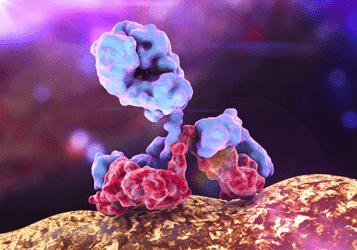- Home
- Products
- Customized ADCs
- FOLH1
- Anti-FOLH1-SMCC-DM1 ADC-3
Anti-FOLH1-SMCC-DM1 ADC-3 (CAT#: ADC-W-603)
This ADC product is comprised of an anti-FOLH1 monoclonal antibody (clone J591) conjugated via a SMCC linker to DM1. The DM1 is targeted to certain cancers by immunerecognition and delivered into cancer cells via receptor mediated endocytosis. Within the cell, DM1 binds to tubulins, interrupts microtubule dynamics, and subsequently, induces cell death.
- Product Information
- ADC Target
- ADC Antibody
- ADC Linker
- ADC payload drug
- Antibody clone #
- J591
- Similar to
- MLN2704
- Name
- FOLH1
- Alternative Names
- FOLH1; folate hydrolase (prostate-specific membrane antigen) 1; PSM; FGCP; FOLH; GCP2; PSMA; mGCP; GCPII; NAALAD1; NAALAdase; glutamate carboxypeptidase 2; NAALADase I; glutamate carboxylase II; glutamate carboxypeptidase II; membrane glutamate carboxypep
- Target Entrez Gene ID
- 2346
- Target UniProt ID
- Q04609
- Overview
- This gene encodes a type II transmembrane glycoprotein belonging to the M28 peptidase family. The protein acts as a glutamate carboxypeptidase on different alternative substrates, including the nutrient folate and the neuropeptide N-acetyl-l-aspartyl-l-glutamate and is expressed in a number of tissues such as prostate, central and peripheral nervous system and kidney. A mutation in this gene may be associated with impaired intestinal absorption of dietary folates, resulting in low blood folate levels and consequent hyperhomocysteinemia. Expression of this protein in the brain may be involved in a number of pathological conditions associated with glutamate excitotoxicity. In the prostate the protein is up-regulated in cancerous cells and is used as an effective diagnostic and prognostic indicator of prostate cancer. This gene likely arose from a duplication event of a nearby chromosomal region. Alternative splicing gives rise to multiple transcript variants encoding several different isoforms.
- Overview
- Anti-FOLH1 Antibody, clone # J591
- Clone #
- J591
- Species Reactivity
- Human
- Name
- SMCC (N-succinimidyl 4-(Nmaleimidomethyl)cyclohexane-1-carboxylate)
- Description
- Disulfide Linkers, are extensively exploited as a chemically labile linkage. Since the release of disulfide-linked drugs requires a cytoplasmic thiol cofactor, such as glutathione (GSH). Disulfides maintain stable at physiological pH and only when ADCs are internalized inside cells, the cytosol provides reducing environment including intracellular enzyme protein disulfide isomerase, or similar enzymes, drugs can be released.
- Name
- DM1 (N2’-Deacetyl-N2’-(3-mercapto-1-oxopropyl)maytansine)
- Description
- Derived from Maytansinoid,a group of cytotoxins structurally similar to rifamycin, geldanamycin, and ansatrienin. The eponymous natural cytotoxic agent maytansine is a 19-member lactam (ansa
macrolide) structure originally isolated from the Ethiopian shrub Maytenus ovatus. Maytansinoids can bind to tubulin at or near the vinblastine-binding site, which interfere the formation of microtubules and depolymerize already formed microtubules, inducing mitotic arrest in the intoxicated cells.
For Research Use Only. NOT FOR CLINICAL USE.
Related Products
- Anti-GPNMB (Glembatumumab)-SMCC-DM1 ADC (CAT#: ADC-W-2598)
- Anti-CCL2 (Carlumab)-MC-Vc-PAB-SN38 ADC (CAT#: ADC-W-756)
- Anti-CD19-MCC-DM1 ADC-5 (CAT#: ADC-W-614)
- Anti-Rabies Virus Glycoprotein (Foravirumab)-MC-Vc-PAB-SN38 ADC (CAT#: ADC-W-1968)
- Anti-FCER2 (Gomiliximab)-SMCC-DM1 ADC (CAT#: ADC-W-1142)
- Anti-CD4 (Ibalizumab)-MC-Vc-PAB-MMAE ADC (CAT#: ADC-W-893)
- Anti-ITGA5 (Volociximab)-SPDB-DM4 ADC (CAT#: ADC-W-1479)
- Anti-IGF1R (Dalotuzumab)-MC-Vc-PAB-DMEA-(PEG2)-duocarmycin SA ADC (CAT#: ADC-W-1267)
- Anti-C. albicans Hsp90 (Efungumab)-SPDB-DM4 ADC (CAT#: ADC-W-2193)
- Anti-LAMP1-SPDB-DM4 ADC-1 (CAT#: ADC-W-095)
Published Data
+ Submit Publications

Scientific Resources
Customer Reviews and FAQs
There are currently no Customer reviews or questions for ADC-W-603. Click the button above to contact us or submit your feedback about this product.
Quick Links
Other Products
Same Target
Same Linker
Same Payload
| CAT# | Product Name | Linker | Payload |
| ADC-W-157 | Anti-FOLH1-VC-MMAF ADC | VC (valine-citrulline) | MMAF (Monomethyl auristatin F) |
| ADC-W-1161 | Anti-FOLH1 (Capromab)-SPDB-DM4 ADC | SPDB (N-succinimidyl-4-(2-pyridyldithio)butyrate) | DM4 (N2'-Deacetyl-N2'-(4-mercapto-4-methyl-1-oxopentyl)maytansine) |
| ADC-W-431 | Anti-FOLH1-VC-MMAE ADC-2 | VC (valine-citrulline) | MMAE (Monomethyl auristatin E) |
| ADC-W-432 | Anti-FOLH1-Mc-VC-MMAE ADC-2 | mc-VC (maleimidocaproyl-valine-citrulline) | MMAE (Monomethyl auristatin E) |
| ADC-W-1162 | Anti-FOLH1 (Capromab)-MC-MMAF ADC | MC (maleimidocaproyl) | MMAF |
| CAT# | Product Name | Linker | Payload |
| ADC-W-504 | Anti-EGFR (cetuximab)-SMCC-Doxorubicin ADC | SMCC (N-succinimidyl 4-(Nmaleimidomethyl)cyclohexane-1-carboxylate) | Doxorubicin |
| ADC-W-2604 | Anti-ITGB3 (Tadocizumab)-SMCC-DM1 ADC | SMCC (N-succinimidyl 4-(Nmaleimidomethyl)cyclohexane-1-carboxylate) | DM1 (N2'-Deacetyl-N2'-(3-mercapto-1-oxopropyl)maytansine) |
| ADC-W-457 | Anti-MST1R-SMCC-DM1 ADC-1 | SMCC (N-succinimidyl 4-(Nmaleimidomethyl)cyclohexane-1-carboxylate) | DM1 (N2’-Deacetyl-N2’-(3-mercapto-1-oxopropyl)maytansine) |
| ADC-W-2589 | Anti-EGFR (Cetuximab)-SMCC-DM1 ADC | SMCC (N-succinimidyl 4-(Nmaleimidomethyl)cyclohexane-1-carboxylate) | DM1 (N2'-Deacetyl-N2'-(3-mercapto-1-oxopropyl)maytansine) |
| ADC-W-479 | Anti-CD74-SMCC-Dox ADC | SMCC (N-succinimidyl 4-(Nmaleimidomethyl)cyclohexane-1-carboxylate) | Doxorubicin |
| CAT# | Product Name | Linker | Payload |
| ADC-AA-050 | Protein G-MCC-DM1 ADC | MCC (Maleimidomethyl cyclohexane-1-carboxylate) | DM1 (N2’-Deacetyl-N2’-(3-mercapto-1-oxopropyl)maytansine) |
| ADC-AA-026 | anti-MIgG(Fc)-N-DM1 ADC | Noncleavable linkers | DM1 (N2’-Deacetyl-N2’-(3-mercapto-1-oxopropyl)maytansine) |
| ADC-W-582 | Anti-ERBB2-SMCC-DM1 ADC | SMCC (N-succinimidyl 4-(Nmaleimidomethyl)cyclohexane-1-carboxylate) | DM1 (N2’-Deacetyl-N2’-(3-mercapto-1-oxopropyl)maytansine) |
| ADC-AA-031 | anti-MIgG(Fc)Fab-N-DM1 ADC | Noncleavable linkers | DM1 (N2’-Deacetyl-N2’-(3-mercapto-1-oxopropyl)maytansine) |
| ADC-W-572 | Anti-ERBB2 (Trastuzumab-Fab)-SPP-DM1 ADC | SPP (N-succinimidyl-4-(2-pyridyldithio)pentanoate) | DM1 (N2’-Deacetyl-N2’-(3-mercapto-1-oxopropyl)maytansine) |
Online Inquiry
Welcome! For price inquiries, please feel free to contact us through the form on the left side. We will get back to you as soon as possible.



